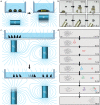Ferrofluid Microdroplet Splitting for Population-Based Microfluidics and Interfacial Tensiometry
- PMID: 32714752
- PMCID: PMC7375242
- DOI: 10.1002/advs.202000359
Ferrofluid Microdroplet Splitting for Population-Based Microfluidics and Interfacial Tensiometry
Abstract
Ferrofluids exhibit a unique combination of liquid properties and strong magnetic response, which leads to a rich variety of interesting functional properties. Here, the magnetic-field-induced splitting of ferrofluid droplets immersed in an immiscible liquid is presented, and related fascinating dynamics and applications are discussed. A magnetic field created by a permanent magnet induces instability on a mother droplet, which divides into two daughter droplets in less than 0.1 s. During the splitting process, the droplet undergoes a Plateau-Rayleigh-like instability, which is investigated using high-speed imaging. The dynamics of the resulting satellite droplet formation is shown to depend on the roughness of the supporting surface. Further increasing the field results in additional splitting events and self-assembly of microdroplet populations, which can be magnetically actuated. The effects of magnetization and interfacial tension are systematically investigated by varying magnetic nanoparticles and surfactant concentrations, and a variety of outcomes from labyrinthine patterns to discrete droplets are observed. As the splitting process depends on interfacial tension, the droplet splitting can be used as a measure for interfacial tension as low as 0.1 mN m-1. Finally, a population-based digital microfluidics concept based on the self-assembled microdroplets is presented.
Keywords: ferrofluids; fluid dynamics; interfacial tension; magnetic fields; magnetic nanoparticles; microfluidics.
© 2020 The Authors. Published by WILEY‐VCH Verlag GmbH & Co. KGaA, Weinheim.
Conflict of interest statement
The authors declare no conflict of interest.
Figures




References
-
- Rosensweig R. E., Ferrohydrodynamics, Courier Corporation, North Chelmsford, MA: 2013.
-
- Colloidal Magnetic Fluids: Basics, Development and Application of Ferrofluids (Ed: Odenbach S.), Springer, Berlin: 2009.
-
- Nkurikiyimfura I., Wang Y., Pan Z., Renewable Sustainable Energy Rev. 2013, 21, 548.
-
- Bahiraei M., Hangi M., J. Magn. Magn. Mater. 2015, 374, 125.
-
- Backholm M., Vuckovac M., Schreier J., Latikka M., Hummel M., Linder M. B., Ras R. H. A., Langmuir 2017, 33, 6300. - PubMed
LinkOut - more resources
Full Text Sources
Research Materials
